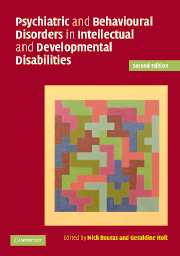Book contents
- Frontmatter
- Contents
- List of contributors
- Preface
- Part I Assessment and diagnosis
- 1 Diagnosis of mental disorders in people with intellectual disabilities
- 2 Mental health assessment and monitoring tools for people with intellectual disabilities
- 3 Inter-disciplinary multi-modal assessment for mental health problems in people with intellectual disabilities
- 4 The relationship between challenging behaviours and psychiatric disorders in people with severe intellectual disabilities
- 5 The interface between medical and psychiatric disorders in people with intellectual disabilities
- Part II Psychopathology and special topics
- Part III Treatment and therapeutic interventions
- Part IV Policy and service systems
- Index
- References
4 - The relationship between challenging behaviours and psychiatric disorders in people with severe intellectual disabilities
from Part I - Assessment and diagnosis
Published online by Cambridge University Press: 15 December 2009
- Frontmatter
- Contents
- List of contributors
- Preface
- Part I Assessment and diagnosis
- 1 Diagnosis of mental disorders in people with intellectual disabilities
- 2 Mental health assessment and monitoring tools for people with intellectual disabilities
- 3 Inter-disciplinary multi-modal assessment for mental health problems in people with intellectual disabilities
- 4 The relationship between challenging behaviours and psychiatric disorders in people with severe intellectual disabilities
- 5 The interface between medical and psychiatric disorders in people with intellectual disabilities
- Part II Psychopathology and special topics
- Part III Treatment and therapeutic interventions
- Part IV Policy and service systems
- Index
- References
Summary
Introduction
Knowledge continues to increase about psychiatric disorders in people with intellectual disabilities (ID). The overwhelming bulk of the research activity has concentrated on those individuals with mild ID. Yet even though people with severe (and profound) ID make up less than 10% of the total ID population (Fryers and Russell, 2004), they provide a disproportionate amount of referrals to specialist ID services (Day, 1985). The major reason for referral of those with more severe ID is for problem (or ‘challenging’) behaviours, such as aggressive, self-injurious and destructive behaviours. They tend to have more frequent and more severe challenging behaviours compared with those with milder ID (Emerson and Bromley, 1995; Jacobsen, 1982). It has long been established that there are multiple factors associated with these behaviours (McClintock et al., 2003). These include physical health problems, epilepsy, behavioural phenotypes, and communication and sensory difficulties. Some challenging behaviours may also be developmentally appropriate behaviours in a person with more severe ID.
In some people with more severe ID, challenging behaviours can be associated with psychiatric symptoms and disorders. Many clinicians have suggested that some of these behaviours may be either caused or exacerbated by the coexisting psychiatric disorders. If this hypothesis is supported then improved detection (and treatment) of the associated psychiatric disorders may potentially reduce both the human suffering and the economic burden that challenging behaviours cause. However, the inter-relationships between challenging behaviours and psychiatric symptoms have until recently remained a relatively neglected area of research.
- Type
- Chapter
- Information
- Publisher: Cambridge University PressPrint publication year: 2007
References
- 8
- Cited by

